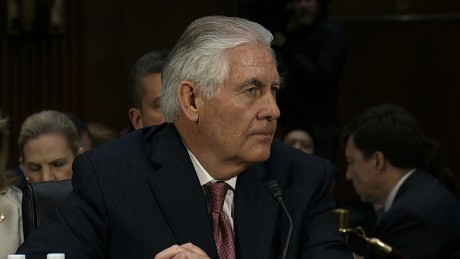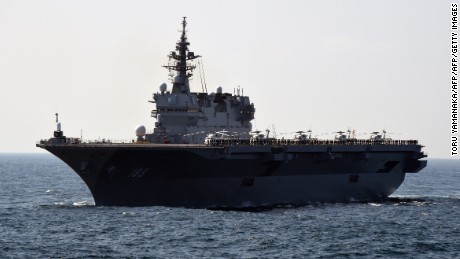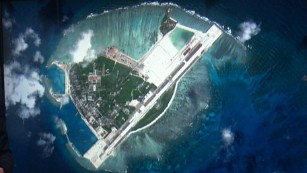Japan's largest warship to train with US Navy
Japan's largest warship will set sail this summer to train with naval ships from the United States and India as part of the annual "Malabar" joint exercise, a Pentagon official told CNN on Monday.
The addition of the Izumo helicopter carrier, which specializes primarily in anti-submarine missions, marks a rare show of naval force from Japan amid growing tensions across Asia and highlights the Trump administration's intention to maintain a cooperative military presence in the region.

North Korea fires 4 ballistic missiles
The Malabar military exercises have taken place on a rotational basis in the West Pacific and Indian oceans since Japan became a regular participant in 2007.
To get to the Indian Ocean, the shortest route will take the Izumo through the contested South China Sea.
China has already made its dissatisfaction with the exercises clear. In December, a Global Times editorial said the exercises would "jeopardize the peace and stability in the (region)."
The 2017 exercises comes at a time of high tension in the Asia region.
North Korean missiles that fell in waters off Japan last week brought new fears in Tokyo about what Kim Jong Un's regime has planned. North Korea said the tests were carried out by the military unit tasked with taking on US military bases in Japan.
Japan and China have locked horns over the Senkaku Islands, the Tokyo-administered chain claimed by Beijing, which refers to them as the Diaoyu Islands.
Then there is the dispute in the South China Sea, particularly Beijing's continued building of man-made islands that has ratcheted up tensions with US allies in the region.
President Donald Trump and Secretary of State Rex Tillerson have also been critical of China's actions in the South China Sea.

Tillerson slams China over South China Sea
"Building islands and then putting military assets on those islands is akin to Russia's taking of Crimea. It's taking of territory that others lay claim to," Tillerson said in his confirmation hearing.
"We're going to have to send China a clear signal that first, the island-building stops, and second, your access to those islands (is) also not going to be allowed."
Secretary Tillerson will visit Asia this week, with stops planned in South Korea, China and Japan.
Next month, Trump plans to host Chinese President Xi Jinping for a summit at his Mar-a-Lago estate in Florida, a senior administration official told CNN Monday.
The US also announced Monday that it will permanently station attack drones in South Korea, a move that comes just days after South Korea received the first parts of the controversial US-made THAAD missile defense system.
"The US wants to, and I think it needs to, be seen as responsive to developments in the region," said Yvonne Chiu, a professor at Hong Kong University.
Reuters first reported the Izumo's addition to the large-scale exercises.
Japan's pacifist constitution limits its offensive firepower, but the 816-foot Izumo is one of Japan's few tools that allow it to project military power beyond the defense of its own territories.
The addition of the Izumo to the already large-scale exercises underscores that Japan's anti-submarine warfare capabilities are key to attempting to deter Chinese expansion in the region, some analysts said.
"Subsurface detection and reaction is a Japanese strength in both technological and operational terms, and a Chinese weakness, even if (China) quantitatively has a larger subsurface fleet," said Corey Wallace, a security analyst at Freie University in Berlin.
Japan has excellent submarine hunting vessels, helicopter carriers and sub-hunting aircraft and a surprisingly long history of using them, Wallace said, even helping the US keep the Soviet Pacific subsurface fleet "bottled up" in the North Pacific during the Cold War.
Why Trump and Tillerson could make waves for US-China relations
Despite plans for the Izumo to train with US ships as part of Malabar, the US Navy declined to comment on whether the Japanese vessel would be deployed to the contentious South China Sea.
"The US Navy does not comment on Japanese Navy movements," a Navy official said.
The Japanese government did not respond to a request for comment.
Japan does not have any claim over the disputed waters, but China's growing military presence has fueled concerns in Tokyo and prompted a pledge to increase patrol and training activities in the area.
The South China Sea dispute will likely be discussed during Tillerson's trip to Asia this week and when Xi visits Trump in Florida.
News Courtesy: www.cnn.com












